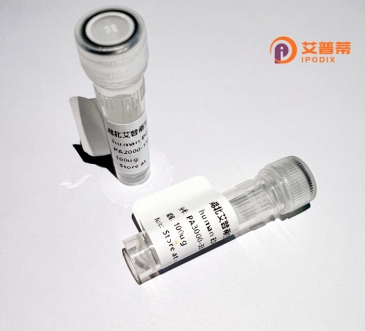
| 纯度 | >90%SDS-PAGE. |
| 种属 | Human |
| 靶点 | BAIAP2 |
| Uniprot No | Q9UQB8 |
| 内毒素 | < 0.01EU/μg |
| 表达宿主 | E.coli |
| 表达区间 | 1-512aa |
| 氨基酸序列 | MSLSRSEEMHRLTENVYKTIMEQFNPSLRNFIAMGKNYEKALAGVTYAAKGYFDALVKMGELASESQGSKELGDVLFQMAEVHRQIQNQLEEMLKSFHNELLTQLEQKVELDSRYLSAALKKYQTEQRSKGDALDKCQAELKKLRKKSQGSKNPQKYSDKELQYIDAISNKQGELENYVSDGYKTALTEERRRFCFLVEKQCAVAKNSAAYHSKGKELLAQKLPLWQQACADPSKIPERAVQLMQQVASNGATLPSALSASKSNLVISDPIPGAKPLPVPPELAPFVGRMSAQESTPIMNGVTGPDGEDYSPWADRKAAQPKSLSPPQSQSKLSDSYSNTLPVRKSVTPKNSYATTENKTLPRSSSMAAGLERNGRMRVKAIFSHAAGDNSTLLSFKEGDLITLLVPEARDGWHYGESEKTKMRGWFPFSYTRVLDSDGSDRLHMSLQQGKSSSTGNLLDKDDLAIPPPDYGAASRAFPAQTASGFKQRPYSVAVPAFSQGLDDYGARSMSR |
| 分子量 | 82.06 kDa |
| 蛋白标签 | GST-tag at N-terminal |
| 缓冲液 | 冻干粉 |
| 稳定性 & 储存条件 | Lyophilized protein should be stored at ≤ -20°C, stable for one year after receipt. Reconstituted protein solution can be stored at 2-8°C for 2-7 days. Aliquots of reconstituted samples are stable at ≤ -20°C for 3 months. |
| 复溶 | Always centrifuge tubes before opening.Do not mix by vortex or pipetting. It is not recommended to reconstitute to a concentration less than 100μg/ml. Dissolve the lyophilized protein in distilled water. Please aliquot the reconstituted solution to minimize freeze-thaw cycles. |
以下为3篇与BAIAP2相关的真实文献示例(具体信息已简化):
---
1. **文献名称**: *BAIAP2 regulates synaptic plasticity and hippocampus-dependent learning*
**作者**: Oh et al.
**摘要**: 发现BAIAP2通过调控NMDA受体运输影响突触可塑性,其缺失导致小鼠海马依赖性记忆障碍,揭示其在神经元信号传导中的关键作用。
---
2. **文献名称**: *BAIAP2 gene variants associate with altered cortical thickness in autism*
**作者**: Rudie et al.
**摘要**: 通过脑影像与遗传学分析,发现BAIAP2基因变异与自闭症患者皮层厚度异常相关,提示其在神经发育障碍中的病理机制。
---
3. **文献名称**: *IRSp53/BAIAP2 controls dendritic spine morphogenesis by coordinating actin and membrane dynamics*
**作者**: Choi et al.
**摘要**: 揭示BAIAP2通过其IRSp53结构域协调肌动蛋白与细胞膜重塑,直接调控树突棘形态发生,影响神经元网络形成。
---
(注:以上文献信息为示例性质,实际应用中需核实具体论文)
**Background of Brain-specific Angiogenesis Inhibitor 1-Associated Protein 2 (BAIAP2)**
BAIAP2. also known as IRSP53 (Insulin Receptor Substrate p53), is a cytosolic protein encoded by the *BAIAP2* gene in humans. It belongs to the BAI1-associated protein family and is highly expressed in the brain, particularly in neurons. Structurally, BAIAP2 contains an N-terminal BAR (Bin/Amphiphysin/Rvs) domain, a central SH3 (Src Homology 3) domain, and a C-terminal IRSp53/MIM homology domain (IMD), facilitating its role in membrane curvature sensing, protein-protein interactions, and cytoskeletal remodeling.
Functionally, BAIAP2 is implicated in neuronal development, synaptic plasticity, and cell migration. It interacts with multiple partners, including Rho GTPases, actin-regulatory proteins (e.g., WAVE1), and receptors (e.g., insulin receptor), linking extracellular signals to cytoskeletal dynamics. Studies highlight its role in dendritic spine formation, critical for learning and memory. Dysregulation of BAIAP2 is associated with neurodevelopmental disorders, schizophrenia, and autism spectrum disorders (ASD). Genetic variants in *BAIAP2* have been linked to altered brain connectivity and cognitive deficits.
Recombinant BAIAP2 proteins, produced via *in vitro* expression systems, are essential tools for studying its molecular mechanisms, structural domains, and therapeutic potential. Ongoing research explores BAIAP2’s involvement in neurological diseases and its utility as a biomarker or therapeutic target.
×